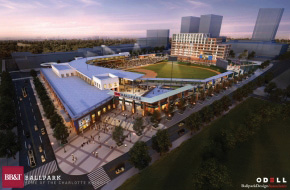After negotiating for several months to finance and build a $55 million ballpark in Charlotte, baseball’s Class AAA Charlotte Knights will receive $7.25 million from the city, $750,000 from Charlotte Center City Partners (an economic and cultural development group), and a donation of public land valued at $20 million to $24 million from Mecklenburg County. In addition to $38 million from the Knights to pay, in part, construction costs, the county will also spend $8 million to improve infrastructure in the Third Ward, the ballpark’s future location in downtown Charlotte. The team is expected to move from its site in Fort Mill, S.C., after completing the 2013 season.
In an independent study of sports activity within the Charlotte metropolitan area during 2011, University of North Carolina at Charlotte economist John E. Connaughton estimated that a group of three teams at local colleges and four in professional sports — including the Knights — were responsible for, respectively, direct and total revenue of $402.3 million and $800.6 million, and direct and indirect employment of 6,246 and 9,827 jobs. Because he applied, in part, a relatively large output multiplier of 2.04 and employment multiplier of 24.9 in his study, these seven teams had a significant impact on direct and total on-site and off-site revenue and employment from sports activities. (According to the output multiplier, for each dollar of direct expenditure on sporting events, the total impact on economic output in the region is $2.04. According to the employment multiplier, each million dollars in direct spending creates 24.9 jobs.) Hired by the Charlotte Regional Sports Commission, Connaughton simply made it easier for city and county officials to approve public money and/or assets to build a new baseball venue.
 |
Despite these results, there are reasons why subsidizing the construction of a ballpark with public money misallocates resources and may waste taxpayer money. For example, what are the implications if Knights teams fail to entertain local sports fans and do not experience an increase in total attendance at their home games from 279,107 — ranked last in the International League in 2011 — to approximately 600,000 or more in future
 |
Architect renderings show the exterior and footprint of BB&T Ballpark in downtown Charlotte’s Third Ward.
Photo by: ODELL |
years? Although a much larger fan base exists in Mecklenburg County than in the club’s current York County (S.C.) home, higher ticket prices and parking fees, more crime and traffic congestion, and lack of support for minor league baseball are potential problems with playing day and night games in a ballpark in downtown Charlotte.
If a recession, higher unemployment or sluggish growth in economic activity occurs in the local or regional economy, will people in Charlotte decide to reduce their expenditures on professional sports and therefore not attend Knights games at their subsidized ballpark? Besides influencing the team’s gate receipts and concession sales at its home games, this would negatively affect the city’s economic development and perhaps reduce revenues and profits of any businesses adjacent to or near the ballpark.
Some critics suggest that too many professional sports franchises exist in a relatively small market. These include the popular Carolina Panthers, the less-popular Charlotte Bobcats, the MLL Charlotte Hounds and the AHL Charlotte Checkers. That is, most local fans prefer to attend pro football and basketball games rather than those in baseball, while others in the group enjoy contests of ice hockey, lacrosse and soccer teams. If so, then the Knights will likely struggle to perform well enough to succeed in their new ballpark.
If there is less consumer demand than forecast for the Knights home games during and after 2014, BB&T Corp. may terminate its naming rights contract when it expires in 2031 or, alternatively, negotiate to reduce the (undisclosed) amount paid for these rights. As a result, the baseball franchise’s revenues will decline and limit opportunities to advertise and promote its brand, products and services in the media and to customers and commercial organizations. Consequently, it is risky and perhaps an unprofitable investment for government and the Center City Partners to subsidize construction of the team’s ballpark in Charlotte.
To pay its share of the facility, the city of Charlotte will divert $7.25 million from a hotel/motel occupancy tax. Apparently, a majority of City Council members think this is the most efficient use of that money rather than spending it on something else associated with tourism. However, if locating the Knights in Charlotte results in more jobs and socioeconomic benefits for residents of the Charlotte metropolitan area, then the Council made a smart decision.
In contrast to my views, Tommy John, former major leaguer and Knights community relations director and color commentator for home radio broadcasts, shared with me these comments about the ballpark: “It should have happened years ago. [On] 72 [days and] nights [of Knights home games], there will be 5-8,000 fans in downtown Charlotte. Attendance will increase with [a] new stadium downtown. Then it’s up to [the] Knights to ‘bring in’ the fans. It’s all about marketing.”
I hope John’s prediction becomes true, although ideologically I discourage the redistribution of taxpayer money and/or resources for privately owned sports facilities and franchise operations that benefit only a fraction of the population.
Frank P. Jozsa Jr. (Frank.Jozsa@fsmail.pfeiffer.edu) is a former professor of economics and business administration at Pfeiffer University in North Carolina. He is the author of 10 books on professional team sports, including three on organized baseball. Bill Focht contributed to this column.






